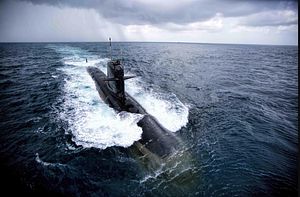The Indian Navy’s second Scorpene-class (Kalvari-class) diesel-electric attack submarine, christened Khanderi, has begun sea trials off the coast of Mumbai on June 1, the Indian Ministry of Defense (MoD) reports.
“The successful trial moved the submarine a significant step closer to her induction into the Indian Navy later this year,” a senior Indian Navy official told The Times of India on June 2. “She will now be put through her paces via a rigorous set of trials, which are designed to test her operating envelop to the maximum.”
According to the MoD, the submarine’s maiden sea sortie will be the first major trial for its propulsion system. As I reported earlier in the year, the Khanderi, the second of the Indian Navy’s future fleet of six Kalvari-class diesel-electric attack submarines, was launched at the state-run Mazgaon Docks Limited (MDL) in Mumbai on January 12.
The lead sub of the class, Kalvari, is slated to be commissioned in July or August following extensive sea trials and weapons tests, which included the test firing of torpedoes and a French-made Exocet SM39 anti-ship missile. The Exocet SM39 is a sea-skimming, subsonic, solid-fueled anti-ship missile with an estimated operational range of 50-70 kilometers, designed to attack small- to medium-size surface warships.
As I explained elsewhere:
The acquisition of the Exocet came under intense scrutiny following the August 2016 disclosure of a data leak at French shipbuilder Direction des Constructions Navales Services (DCNS), which publicly revealed sensitive details on the anti-ship missile including launch details, the number of targets the missile is capable of processing, and how many targets could be downloaded before firing.
Nevertheless, the Indian MoD insisted that the leaked data does not constitute a security compromise and reiterated its intention to procure the missiles for the Kalvari-class.
DCNS was awarded a $4.16 billion contract (known as Project 75-I) to build six diesel electric attack submarines for the Indian Navy in in cooperation with MDL in 2005. The Project 75-I contract included the option of building six additional Scorpene-class submarine at MDL. However, following the data leak, the Indian Navy decided to abandon plans to place an order to six additional subs with DCNS (See: “India Drops Plans to Add 3 More French Stealth Attack Submarines”). I reported:
With DCNS apparently out of the competition for the next phase of Project 75-I, India will have to look among the French ship maker’s competitors – including Navantia (Spain), Kockums (Sweden), Rubin Design Bureau-Amur Shipyard (Russia), Mitsubishi Heavy Industries, and Kawasaki Heavy Industries (Japan) – to choose a foreign defense contractor to build an additional six diesel-electric attack submarines in Mumbai.
The four remaining 1,550-ton Kalvari-class subs, fitted with air-independent propulsion systems, will be delivered by 2020 at an interval of nine months.































